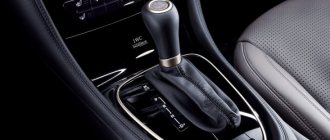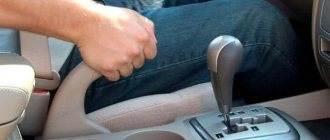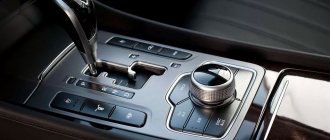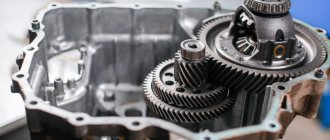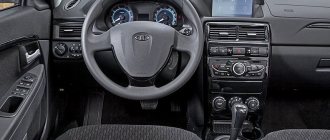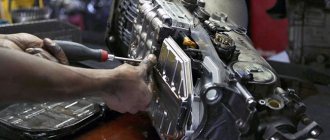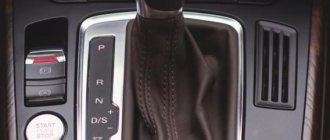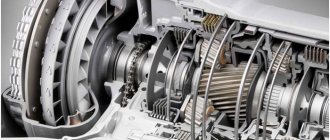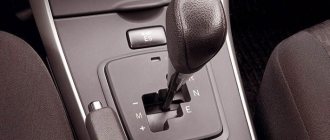Where is the gas and where is the brake in a car with an automatic transmission? The pedals are located taking into account the design of the car, the ergonomic and psychological qualities of the driver. The brake and gas must work properly so that the health and life of the driver, passengers, pedestrians and animals that suddenly run out onto the road are safe. Therefore, it is important to know how the car’s mechanisms work, be able to control them and recognize problems.
Features of automatic transmission
One of the important components of the car is the gearbox, through which the wheels receive energy from the engine. If you use it ineptly, or choose the type of unit that is inappropriate for your driving style, the car will not obey the driver. Therefore, for many, an automatic transmission is preferable as it is the easiest to operate. Read about what unit options there are and the nuances of their use in this article.
There are several types of the most important transmission unit; the choice depends on many factors and personal preferences. The conditions for using the vehicle are also important.
Mechanics
A manual transmission allows the driver, using the clutch pedal and the gear selector knob, to set the optimal operating mode of the engine, and therefore the rotation of the wheels. With such a car, you can independently choose the driving speed depending on the characteristics of the road. In certain conditions, a manual transmission makes a car safer.
But this type of unit is more suitable for an experienced driver. After all, you need to not only correctly assess the situation on the road, but also not get confused in the actions that will allow the car to move and change speed.
A manual transmission is more affordable in comparison to an automatic transmission and is more suitable for those who like to accelerate sharply. And its gas mileage is lower than that of vehicles with automatic transmission.
We recommend reading about the fine for low speed. From the article you will learn whether there is a penalty for low speed, how the violation is recorded, and the experience of other countries.
And here is more information about what the fine for speeding will be.
Variable speed drive
When asked which gearbox is better - automatic or variator, this is not entirely correct. After all, the second is an improved version of the first. The variator allows you to shift gears smoothly, which gives the car a smooth ride. These features help save gasoline; during sharp switching, its consumption is higher. Nevertheless, you can accelerate faster in a car with a CVT than with an automatic transmission.
Cars with such a box are quite expensive. The unit is crammed with electronics, which is difficult and expensive to repair. You need to use expensive oil so that the valve body does not clog or the belt breaks. If this happens, the transmission may not even be able to be fixed. Another drawback of the variator is its “dislike” for frequent stops and slipping.
Robot
Robotic gearboxes are a mechanical unit, only controlled electronically. It is quite difficult to say which gearbox is better - automatic or robot, since the latter also has its advantages. There is no clutch and no need to change the speed yourself. Instead of an extra pedal, an electric drive and a lever are installed. That is, the car is easy to drive, and it does not require frequent refueling.
But a robotic gearbox can make the car drive jerkily, since gear shifts occur with a hitch.
Machine
The automatic transmission has a torque converter instead of a clutch. There is no extra pedal in the car, since the liquid-filled part connects the engine to the automatic transmission. Switching speeds occurs quickly and smoothly. Everything is commanded by a control unit that selects an indicator depending on road conditions. The driver only needs to set the driving mode using the lever. You don't need to think about what to do to get moving.
How many gears are there in an automatic transmission?
Automatic transmissions have been used since the 30s of the 20th century. They have improved more than once. And how many gears there are on an automatic transmission depends on the make and model of the car. Most have 4, but newer cars already have 6. And there are cars with 8 gears, for example, Lexus. The fewer there are, the easier the transport is to maintain.
But 6 gears provide smooth driving, fast acceleration, and fuel economy. Only specialists can repair the unit. After all, to get to it, you will have to disassemble half the car.
Watch this video about what the letters on the automatic transmission mean:
How to use automatic gear shifter
You can change the speed while driving. This is done automatically, and the driver only presses harder and weaker on the gas pedal. The speed is changed when using modes R and D. In the latter case, of course, this is required more often. After all, D means moving forward. If you press the gas pedal all the way, the speed will be maximum.
How not to use a machine gun
There are also prohibitions when driving a car with automatic transmission, failure to comply with which will lead to breakdown or accident. It is forbidden:
- Switch the mode, that is, move the lever until the vehicle stops. It may skid or overturn.
- Start the car using the “towing” method. You won't be able to move it from its place, and the box can be damaged.
- Turn on modes that are opposite to each other at speed. For example, when using D (“forward”), immediately R (“reverse”) or P (“park”).
- Use N (“neutral”) mode when driving. This is especially undesirable when driving downhill.
- Fill your car with untested oils. You can only use those approved by the manufacturer.
You definitely need to go to the service station for preventive maintenance, even if everything is fine with the car. The automatic transmission makes it necessary to change the oil at certain times and perform other actions for subsequent trouble-free use of the car.
Features of automatic transport control
If your car has an automatic transmission, it is important to know how to use the equipment:
- To start driving, start the engine, press the brake and move the lever to the desired position. Usually this is mode D - “forward”. Then the brake pedal is released and the gas is pressed, after which the car will move smoothly.
- Fast braking will require pressing the appropriate pedal. Then the car will stop almost immediately. If there is no need for immediate braking, you should release the accelerator. When the car stops, it is switched to mode P. This is a stop at which the wheels are blocked.
- When parking for a long time, do not ignore the handbrake. Especially when there is a slope on the road.
If the car has an automatic transmission, shifting gears allows you to select the driving mode. Smart technology does this too. The driver only moves the lever to a certain position - 2L, 3L, 4L, L. The first means that 2 gears are involved, L - one, etc. These modes are additional; the main ones (D, R, P, N) have already been discussed.
In addition to them, a modern automatic transmission simplifies driving in icy conditions, forced deceleration, on a snowy road, on an incline, if you use:
- Tiptronic or Steptronic. With them, gears can be changed manually, which makes driving on difficult roads safer.
- Sport or Kickdown. It means strengthening the engine, which allows you to sharply increase speed at the right moments.
- D3(S). Moving the lever to a division means using a lower gear, which increases safety on the descent. This makes the car easier to control.
- D2. Leads to easier braking. This shift to low gear should be used on slippery roads or steep descents.
- SNOW, W, HOLD, WINTER. These are all designations of winter driving mode under difficult conditions, that is, safer, but also placing an increased load on the gearbox and engine.
We recommend reading about whether a fine is possible for dangerous driving.
From the article you will learn about what is considered dangerous driving, who sets the level of danger, and the fine for violation. And here is more information about the fine for driving while intoxicated.
The popularity of cars with automatic transmission is growing, despite the fact that they require high costs. This is due to the ease of use and safety of the box. But even with an automatic, the art of driving and monitoring the condition of the vehicle do not cease to be relevant.
Useful video
To learn how to use automatic transmission, watch this video:
Didn't find the answer to your question? Find out how to solve exactly your problem - call right now by phone:
It's fast and free!
How to position your feet on the pedals
To prevent leg joints from hurting after hours of traffic jams, you need to position your feet correctly on the levers. The rule is this: the left one is resting, the right one is working “for two”. The machine has a raised platform for the left foot, to the left of the brake. The right foot rests on the heel placed above the brake pedal, and the top of the foot is “thrown” between the brake and the gas to shift.
The height of the pedals in cars with an automatic transmission can be at different levels. This way the driver will be confident in his maneuvers and will not be able to brake and press the gas with one foot at the same time.
Some drivers practice the “2 pedals = 2 feet” technique. The right foot is kept entirely on the gas, and the left foot on the brake pedal - to work according to this scheme on an automatic machine, you will have to practice a lot.
Each leg placement option has pros and cons. Which foot to use in the machine should be chosen based on your comfort.
The location of the pedals in a car with automatic transmission
The brake and gas pedals are located in the driver's foot space under the automatic dashboard. To avoid confusion, manufacturers make the brake pad wide and the throttle longer.
Some cars are equipped with two brakes. In the automatic machine, instead of a manual parking brake, a “scissor” is installed. The lever is located in the driver's footwell under the dashboard on the left. To lock the parking brake, you need to press it gently. After this, the “scissor” is blocked by a ratchet.
Where is which pedal in a left-hand drive automatic: the brake is located on the left side, and the gas is on the right. In right-hand drive machines, the position of the levers remains in the same order from left to right: brake, gas.
Why press the gas and brake at the same time?
Simultaneously pressing the brake and gas pedals in the automatic transmission spins the engine. The torque converter begins to rotate furiously, but the wheels slow down. The energy from the donut turns into heat, which leads to overheating of the oil and combustion of parts.
Both pedals are used by athletes and only on mechanics in the following cases:
- redistribution of mass between axles on off-road;
- creating a controlled drift;
- maintaining engine speed when braking.
In the automatic machine, they press the gas and brake at the same time, conducting a “Stall Speed Test” - diagnostics of the gearbox and engine. The test determines the maximum engine speed in all selector positions with the gas fully depressed and the wheels stationary. This procedure can only be performed by experienced drivers.
How to operate the pedals
The arrangement of two pedals in a car with an automatic transmission reduces the load on the driver. Less focus on management required. Legs get less tired. But you need to know some features of the brake and gas operation in an automatic machine:
- The gas and brake must be pressed smoothly so that the car has time to react smoothly.
- You need to switch automatic modes with the brake pressed.
- When a car with an automatic transmission is slipping, pressing on the gas is harmful. To get out, you can try using the pedal as a clutch in a downshift, slowly rotating the wheels.
- In Drive mode, “playing” with the gas changes the automatic gears: if you press the gas 2/3 during acceleration, the engine will spin up in this gear without shifting higher. To downshift, you need to quickly press the gas and release slightly.
- In manual mode, releasing the throttle at low speed puts the torque converter into fluid clutch mode. The car is braked by the engine, which is convenient for rough city driving - the foot brake is used less.
- You need to sharply turn off the gas in the “Kick-down” mode. In this case, the automatic switches to 1-2 speeds for overtaking. Frequent use of the aggressive gas mode harms the box.
When overtaking sharply, you need to take into account that in the moment between pressing the gas and accelerating the car there is a delay of about a second. During this time, the automatic transmission shifts into a lower gear and then accelerates. In an emergency situation, such “waiting” can be fatal.
How to start a car without damaging the clutch
Improper starting of a car with an automatic transmission primarily damages the clutch. In an automatic transmission, the torque converter plays the role of clutch. If you press the gas sharply to the floor, the engine will increase speed, and the electronics of the machine will not have time to react at this moment and may jam.
The starting order for a car with an automatic transmission is as follows:
- Get into the car and check the position of the selector. The “P” mode must be set.
- Insert and turn the key in the ignition.
- Warm up the engine to operating speed.
- Apply the foot brake to unlock the selector lever.
- With the brake depressed, turn on mode “D”.
- Release the brake. The car will start moving.
- Smoothly press the gas to accelerate.
